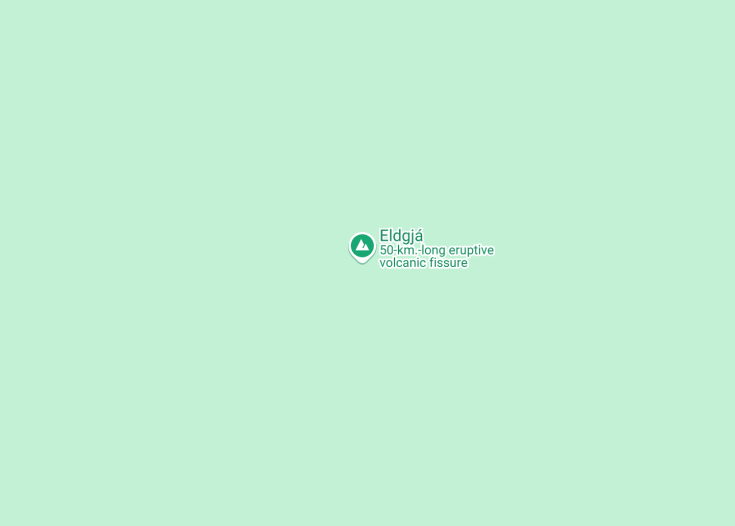Eldgjá, located in the remote highlands of Iceland, is a monumental volcanic canyon that forms part of the Katla UNESCO Global Geopark. Known as the “Fire Canyon,” Eldgjá is famed for its vast size, making it the largest volcanic canyon in the world. This geological wonder was formed during a massive eruption in 934 AD and stretches over 40 kilometers, featuring a breadth of up to 600 meters and depths reaching 150 meters. The area is renowned not only for its historical significance but also for its breathtaking vistas and the picturesque Ófærufoss waterfall cascading beautifully within its confines.
If you’re heading to Eldgjá, make sure to check the weather forecast and prepare for unpredictable conditions. Sturdy hiking boots are essential for navigating the rocky terrain.
Consider visiting during the summer when the highland roads are more accessible. An early start is advisable as it allows more time to explore the canyon and enjoy its natural beauty.
Eldgjá: A volcanic marvel
Eldgjá, known as “the fire canyon,” is a remarkable volcanic fissure in the south of Iceland, near Kirkjubæjarklaustur. This expansive fissure, part of the Katla Geopark, stretches approximately 40 kilometers, making it one of the largest of its kind in the world. Formed during a massive volcanic eruption in 934 AD, Eldgjá is a witness to Iceland’s dynamic geological history. Tourists flock to this site to experience its raw natural beauty and the powerful influence of volcanic activity on Iceland’s landscape.
The area is renowned for its captivating hiking trails that offer stunning views of the surrounding mountains and lava fields. Álfafoss, a beautiful waterfall within the fissure, is yet another highlight, showcasing the unique interaction between water and volcanic terrain. Visiting Eldgjá allows travelers to step into a scene of dramatic natural splendor and to better understand the natural forces that shape the mesmerizing landscapes of Iceland.
Exploring the trails of Eldgjá
Eldgjá offers numerous trails that cater to all levels of hikers, from novices to experienced adventurers. These trails not only allow visitors to explore the vast volcanic fissure but also to immerse themselves in the breathtaking scenery of the Icelandic highlands. One of the most popular hikes is the trek to Öxarárfoss, a spectacular waterfall that cascades beautifully amidst the rugged terrain.
Along the way, hikers can witness the fascinating effects of past eruptions and the ongoing natural reclamation by the local flora. The area’s rugged landscape and raw natural beauty provide perfect opportunities for photography enthusiasts and nature lovers alike.
A highlight at Eldgjá: The stunning Öxarárfoss Waterfall
The Öxarárfoss Waterfall is a notable attraction within the Eldgjá volcanic fissure and an absolute must-see for visitors to the area. The waterfall, part of the River Öxará, falls eloquently into a pool flanked by steep, moss-covered cliffs. What makes Öxarárfoss particularly fascinating is its origin—the result of post-eruption water flow finding its path through the fissure.
The contrast between the waterfall’s crisp, flowing water and the stark black basaltic walls creates a mesmerizing visual effect, further enhanced during winter when the waterfall freezes, forming intricate ice structures. This spot not only offers a moment of tranquility but also a powerful reflection on the ever-present interplay between water and volcanic rock in Iceland’s landscape.
Discover the Wonders of Eldgjá
Eldgjá is a captivating destination for adventure seekers and nature enthusiasts. Ideal for couples and groups, this expansive volcanic canyon offers breathtaking scenery, making it a perfect spot for those looking for an escape into nature. Expect a combination of stunning volcanic landscapes and the opportunity to witness the raw beauty of one of Iceland’s most impressive natural phenomena.
Best Time to Visit Eldgjá
The ideal time to visit Eldgjá is during the summer months, from June to August, when the weather is most favorable for exploring the outdoors. During these months, visitors will find the access roads open and the hiking trails more navigable.
Annual Events
Eldgjá is particularly magical during the Annual Volcano Day, held every July, where visitors can enjoy guided tours that explain the volcanic activity and the history of the area.
Accessibility and Limitations at Eldgjá
Understanding the accessibility and limitations before visiting Eldgjá is crucial.
Accessibility
Limitations
- No overnight camping allowed within the canyon.
- Drone flying is restricted unless prior permission is obtained.
Notes to visitors
- Pack weather-appropriate clothing as conditions can change rapidly.
- Remember to leave no trace and preserve the natural beauty of Eldgjá.
General Information
Plan Your Visit to Eldgjá
Location
Near Iceland’s southern highlands area, Eldgjá is accessible from Route 1, followed by a scenic drive on Route F208. Landmarks include Ofaerufoss waterfall nearby.
Address:
Eldgjá, Kirkjubæjarklaustur, Iceland
Opening Hours
Open year-round but best accessible from June to early September. No specific closure days, but travel may depend on weather conditions.
How to Reach Eldgjá
Car
Driving is the most flexible way to reach Eldgjá, allowing visitors to explore at their own pace.
| Route | Distance | Travel time |
|---|---|---|
| From Reykjavik | 200 km | 3 hours |
| From Vik | 70 km | 1 hour 10 minutes |
| From Akureyri | 300 km | 4 hours |
Attractions Nearby Eldgjá
- Ofaerufoss Waterfall – 3 km (1.9 miles)
- Laki Craters – 25 km (15.5 miles)
- Fjaðrárgljúfur Canyon – 72 km (44.7 miles)
- Skaftafell National Park – 93 km (57.8 miles)
- Jökulsárlón Glacier Lagoon – 144 km (89.5 miles)
- Reynisfjara Black Sand Beach – 78 km (48.5 miles)
- Eldhraun Lava Field – 65 km (40.4 miles)
Common Questions
What is Eldgjá and how was it formed?
What geological features can be seen at Eldgjá?
What types of flora and fauna can be found around Eldgjá?
What are the best times of year to visit Eldgjá?
Are there designated hiking trails at Eldgjá?
Is camping allowed in the Eldgjá area?
How challenging are the hiking trails at Eldgjá?
What safety measures should be taken when visiting Eldgjá?
- Checking weather conditions and road accessibility before departure.
- Informing someone about your travel plans and expected return time.
- Wearing suitable hiking boots and weather-appropriate clothing.
- Carrying sufficient water, food, and a first-aid kit.
- Staying on marked trails to avoid disorientation and minimize environmental impact.
- Being aware of signs of volcanic activity and having a plan for evacuation if necessary.
These precautions will help ensure a safe and enjoyable visit to this spectacular volcanic region.
What historical significance does Eldgjá hold?
Can amateur geologists conduct studies or collect samples at Eldgjá?
How does Eldgjá compare to other volcanic sites in Iceland?
What photography opportunities does Eldgjá offer?

Is eldgjá in kirkjubæjarklaustur worth visiting?
The Eldgjá canyon, located near Kirkjubæjarklaustur, is often considered a must-visit for those who admire unique geological formations and the raw beauty of nature. Known as the ‘Fire Canyon’, Eldgjá is part of the vast volcanic system in Iceland. It holds the distinction of hosting the largest volcanic eruption in the past millennia, which has shaped its dramatic landscape.
For tourists, the site offers stunning vistas and the opportunity to walk through a significant part of Icelandic and geological history. However, accessibility can be a challenge, especially due to the remote location and potentially rough weather conditions. Travelers should be prepared for a rugged experience, possibly requiring a guide for safe navigation. While it’s an incredible site, those with mobility issues or seeking a light, easy trip might find it demanding.









